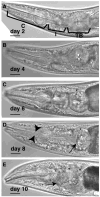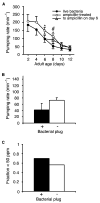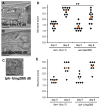Sarcopenia in the Caenorhabditis elegans pharynx correlates with muscle contraction rate over lifespan
- PMID: 16446070
- PMCID: PMC2553216
- DOI: 10.1016/j.exger.2005.12.004
Sarcopenia in the Caenorhabditis elegans pharynx correlates with muscle contraction rate over lifespan
Abstract
In muscles, sarcopenia, the loss of muscle mass, is the major cause of aging-related functional decline and frailty. Several factors are correlated with sarcopenia during aging, including contraction-related cellular injury, oxidative stress, endocrine changes and reduced regenerative potential. However the involvement of these factors has not been experimentally investigated. Here, we report that contraction-related injury may significantly promote the progression of sarcopenia in the pharynx of the nematode, Caenorhabditis elegans, a model of aging in non-regenerative tissues. Both functional and structural declines in the pharynx during aging were significantly delayed in mutants with reduced muscle contraction rates. We also examined the role of bacteria in pharynx muscle decline during aging, as previous studies reported that antimicrobial treatments could extend C. elegans lifespan. Although microbial infection may have enhanced functional decline in the pharynx during aging, it was not the sole cause of decreased pumping rates in old animals. This study identifies contraction-related injury as a factor affecting the initiation and progression of sarcopenia during aging. Further, characterization of the specific types of damage induced by muscle contraction will be helpful for understanding the underlying causes of sarcopenia.
Figures


 ), or ampicillin-treated non-growing bacteria (
), or ampicillin-treated non-growing bacteria (
 ), or transferred to ampicillin-treated bacteria on adult day 6 (
), or transferred to ampicillin-treated bacteria on adult day 6 (
 ). *P=0.006, live versus ampicillin-treated bacteria; #P=0.019, live bacteria versus transferred on day 6; (n), 20 animals, except n=10 animals for days 8, 10 on live bacteria. (B) Average pumping rate in aged (days 7–10) adults with or without bacterial plugging. Error bars, SEM; plugged, n=10 animals; unplugged, n=49 animals; P=0.2, t-test. (C) Fraction of day 7–10 adult animals that pumped fewer than 50 times/min; plugged, n=10 animals; unplugged pharynx, n=49 animals.
). *P=0.006, live versus ampicillin-treated bacteria; #P=0.019, live bacteria versus transferred on day 6; (n), 20 animals, except n=10 animals for days 8, 10 on live bacteria. (B) Average pumping rate in aged (days 7–10) adults with or without bacterial plugging. Error bars, SEM; plugged, n=10 animals; unplugged, n=49 animals; P=0.2, t-test. (C) Fraction of day 7–10 adult animals that pumped fewer than 50 times/min; plugged, n=10 animals; unplugged pharynx, n=49 animals.
 untreated;
untreated;
 5 mg/mL serotonin creatine sulfate) and the change between untreated and serotonin-treatment was not different at different ages (
5 mg/mL serotonin creatine sulfate) and the change between untreated and serotonin-treatment was not different at different ages (
 change in pump rate;
change in pump rate;
 fold change by serotonin); **P<0.001, t-test versus day 2, untreated; n=32–44, except n=12 for day 12. (B) Pumping rate during aging in fem-1(hc17) (◆), tph-1(mg280) (△), eat-2(ad465) (□) and eat-18(ad1110) (○) animals. (C) Relative decline of pumping rate, expressed as a fraction of pumping rate on adult day 2, in strains as presented in part (B); n> 14 animals; *P<0.05, t-test versus same-age wildtype.
fold change by serotonin); **P<0.001, t-test versus day 2, untreated; n=32–44, except n=12 for day 12. (B) Pumping rate during aging in fem-1(hc17) (◆), tph-1(mg280) (△), eat-2(ad465) (□) and eat-18(ad1110) (○) animals. (C) Relative decline of pumping rate, expressed as a fraction of pumping rate on adult day 2, in strains as presented in part (B); n> 14 animals; *P<0.05, t-test versus same-age wildtype.


 ) or transferred to 20 °C after 2 days (
) or transferred to 20 °C after 2 days (
 ) or 15 days (
) or 15 days (
 ) at 25 °C. Significance between e1370 and e1368 pumping rates after d15 transfer, P = 3 × 10−9, t-test, measured on d1 6; n ≥ 20 animals for populations maintained at 20 °C throughout adulthood; for transfers, n=30 (e1370, d2 transfer), 34 (e1370, d15 transfer) and n=29 (e1368 d2 transfer), 33 (d15 transfer).
) at 25 °C. Significance between e1370 and e1368 pumping rates after d15 transfer, P = 3 × 10−9, t-test, measured on d1 6; n ≥ 20 animals for populations maintained at 20 °C throughout adulthood; for transfers, n=30 (e1370, d2 transfer), 34 (e1370, d15 transfer) and n=29 (e1368 d2 transfer), 33 (d15 transfer).
References
-
- Albertson DG, Thomson JN. The pharynx of Caenorhabditis elegans. Philos Trans R Soc Lond. 1976;275:299–325. - PubMed
-
- Avery L. Motor neuron m3 controls pharyngeal muscle relaxation timing in Caenorhabditis elegans. J Exp Biol. 1993;175:283–297. - PubMed
-
- Avery L, Horvitz H. Pharyngeal pumping continues after laser killing of the pharyngeal nervous system of C. elegans. Neuron. 1989;3:473–485. - PubMed
-
- Bolanowski M, Russell R, Jacobson L. Quantitative measures of aging in the nematode Caenorhabditis elegans. I. Population and longitudinal studies of two behavioral parameters. Mech Ageing Dev. 1981;15:279–295. - PubMed
Publication types
MeSH terms
Substances
Grants and funding
LinkOut - more resources
Full Text Sources
Other Literature Sources
Medical

